Effects of Double-Diffusive Convection on Calculation Time and Accuracy Results of a Salt Gradient Solar Pond: Numerical Investigation and Experimental Validation
Abstract
1. Introduction
2. Experimental Setup
2.1. Description of the Salt Gradient Solar Pond
2.2. Measurements System
2.3. Experimental Protocol
3. Numerical Models
3.1. Physical Model
3.2. Absorption of Solar Radiation Model
3.3. Heat Losses through Free Surface, Bottom, and Vertical Walls of the SGSP
3.3.1. Heat Losses through Free Surface
3.3.2. Heat Losses through Bottom and Vertical Walls
3.4. First Numerical Model: Double-Diffusive Convection Is Neglected
3.4.1. Mathematical Model
- The double-diffusive convection in LCZ and UCZ is neglected;
- The temperature is uniform in the UCZ and LCZ;
- The heat transfer in the NCZ takes place vertically along the height z;
- The thermo-physical proprieties of the salt water are independent of the temperature and salt concentration variation and calculated at a reference salinity (Srf = 10%), a reference salt concentration (Crf = 100 kg/m3) and at a reference temperature (Trf = 40 °C) using the following correlations [52]:
- In the upper zone (UCZ), the thermal energy losses from the upper part by three different modes (φtt) are calculated using Equations (17), (13), and (4). In addition, the conduction heat transfer is conducted via the bottom of this zone and the upper part of the non-convective zone (φNCZ/UCZ) and through the sidewalls (φloss). These quantities are obtained using Equations (22) and (18), respectively. Moreover, the quantity of thermal energy absorbed by the UCZ (φsolar,UCZ) is calculated by Formula (23), in which h(z = hUCZ). This last one is obtained from Equation (2).
- In the insulating zone (NCZ), the thermal energy losses by conduction via the vertical walls (φloss) are calculated by Equation (18). In addition, this zone is subdivided into sub-zones of a thickness Δz. Therefore, the heat transfer by conduction is conducted between a sub-zone j and the sub-zone above j−1 (φNCZ j/j−1) and the same between the sub-zone j and the sub-zone below j+1 (φNCZ j+1/j), as expressed Equations (25) and (26), respectively. Moreover, the quantity of thermal energy absorbed by each sub-zone (φsolar,NCZ j) is calculated by Formula (27), in which h(z) is obtained from Equation (2).
- In the storage zone (LCZ), the thermal energy losses by conduction via bottom and vertical walls (φloss) are calculated by Equation (18). Moreover, the conduction heat transfer is conducted via the upper part of this zone and the lower part of the non-convective zone (φLCZ/NCZ), as expressed in Equation (29). In addition, the quantity of thermal energy absorbed by the LCZ (φsolar,LCZ) is expressed by formula (30) in which h(z) is obtained from Equation (2).
3.4.2. Numerical Method
3.5. Second Numerical Model: Double-Diffusive Convection Is Considered
3.5.1. Mathematical Model
- The mixture of water and salt is incompressible and Newtonian fluid;
- The heat and mass transfer are bi-dimensional;
- The flow in the two convective zones is laminar;
- The temperature at the external face of the pond’s vertical walls is the same as the ambient air;
- The Boussinesq approximation is adopted;
- The thermo-physical properties of the saltwater are independent on the temperature and salt concentration variation (calculated using Equations (19)–(21).
3.5.2. Initial and Boundary Conditions
3.5.3. Numerical Method
4. Results and Discussion
4.1. Vertical Variation of the Salt-Water Temperature
4.2. Temporal Variation of the Average UCZ and LCZ Temperatures
4.3. Temporal Variation of Thermal Energy Stored in the SGSP
4.4. Temporal Variation of the Calculation Time
5. Conclusions
- Both numerical models can predict with a good grade of accuracy the thermal behavior of an SGSP (the maximum relative error is less than 10%);
- Due to the absorption of solar radiation, the SGSP temperature varies between 21 °C and 56 °C during the 82 h;
- In the upper zone (UCZ), the average relative error between experimental and numerical results is around 5.98% by using the second model (double-diffusive convection is considered) and increases to about 9.39% by using the first model (double-diffusive convection is neglected);
- In the storage zone (LCZ), the average relative error is about 2.92% for the second model and around 3.74% for the first model;
- The negligence of the double-diffusive convection in the SGSP modeling tends to overestimate the thermal energy stored in the storage zone by about 4.3% after 82 h;
- The calculation time analysis shows that the difference between the two models increases exponentially with the duration of the analysis. The model with double-diffusive convection returns a calculation time hundreds of times larger (207 min while 1 min for the simpler model, after 35 h of analysis);
- The double-diffusive convection developed in the SGSP should be considered in the SGSP modeling (using the second model) in order to avoid overestimation of the numerical results. However, the time calculation required represents the major inconvenience of using such a model.
Author Contributions
Funding
Acknowledgments
Conflicts of Interest
References
- Brahim, A.N.; Rghif, Y.; Bahraoui, F. Numerical investigation of solar energy storage by a salt gradient solar pond in several Moroccan cities. E3S Web Conf. 2022, 336, 00020. [Google Scholar] [CrossRef]
- El-Sebaii, A.A.; Ramadan, M.R.I.; Aboul-Enein, S.; Khallaf, A.M. History of the solar ponds: A review study. Renew. Sustain. Energy Rev. 2011, 15, 3319–3325. [Google Scholar] [CrossRef]
- Ranjan, K.R.; Kaushik, S.C. Thermodynamic and economic feasibility of solar ponds for various thermal applications: A comprehensive review. Renew. Sustain. Energy Rev. 2014, 32, 123–139. [Google Scholar] [CrossRef]
- Velmurugan, V.; Srithar, K. Prospects and scopes of solar pond: A detailed review. Renew. Sustain. Energy Rev. 2008, 12, 2253–2263. [Google Scholar] [CrossRef]
- Rghif, Y.; Zeghmati, B.; Bahraoui, F. Soret and Dufour effects on thermal storage and storage efficiency of a salt gradient solar pond. IEEE Xplore 2020, 5, 1–6. [Google Scholar] [CrossRef]
- Nielsen, C.E. Salinity-Gradient Solar Ponds BT—Advances in Solar Energy: An Annual Review of Research and Development; Böer, K.W., Ed.; Springer: Boston, MA, USA, 1988; pp. 445–498. [Google Scholar]
- Szacsvay, T.; Hofer-Noser, P.; Posnansky, M. Technical and economic aspects of small-scale solar-pond-powered seawater desalination systems. Desalination 1999, 122, 185–193. [Google Scholar] [CrossRef]
- Nakoa, K.; Rahaoui, K.; Date, A.; Akbarzadeh, A. An experimental review on coupling of solar pond with membrane distillation. Sol. Energy 2015, 119, 319–331. [Google Scholar] [CrossRef]
- Suárez, F.; Ruskowitz, J.A.; Tyler, S.W.; Childress, A.E. Renewable water: Direct contact membrane distillation coupled with solar ponds. Appl. Energy 2015, 158, 532–539. [Google Scholar] [CrossRef]
- Manzoor, K.; Khan, S.J.; Jamal, Y.; Shahzad, M.A. Heat extraction and brine management from salinity gradient solar pond and membrane distillation. Chem. Eng. Res. Des. 2017, 118, 226–237. [Google Scholar] [CrossRef]
- Akbarzadeh, A.; Johnson, P.; Singh, R. Examining potential benefits of combining a chimney with a salinity gradient solar pond for production of power in salt affected areas. Sol. Energy 2009, 83, 1345–1359. [Google Scholar] [CrossRef]
- Tundee, S.; Srihajong, N.; Charmongkolpradit, S. Electric power generation from solar pond using combination of thermosyphon and thermoelectric modules. Energy Procedia 2014, 48, 453–463. [Google Scholar] [CrossRef]
- Ziapour, B.M.; Saadat, M.; Palideh, V.; Afzal, S. Power generation enhancement in a salinity-gradient solar pond power plant using thermoelectric generator. Energy Convers. Manag. 2017, 136, 283–293. [Google Scholar] [CrossRef]
- Ding, L.C.; Akbarzadeh, A.; Tan, L. A review of power generation with thermoelectric system and its alternative with solar ponds. Renew. Sustain. Energy Rev. 2018, 81, 799–812. [Google Scholar] [CrossRef]
- Rghif, Y.; Zeghmati, B.; Bahraoui, F. Modeling of a salt gradient solar pond under Moroccan climate taking into account double-diffusive convection. Mater. Today Proc. 2020, 30, 883–888. [Google Scholar] [CrossRef]
- Leblanc, J.; Akbarzadeh, A.; Andrews, J.; Lu, H.; Golding, P. Heat extraction methods from salinity-gradient solar ponds and introduction of a novel system of heat extraction for improved efficiency. Sol. Energy 2011, 85, 3103–3142. [Google Scholar] [CrossRef]
- Chiba, Y. Etude de L’utilisation d’un Bassin D’eau Comme Capteur Solaire. Tunisia. 2005. Available online: https://www.scribd.com/document/495150738/etude-de-l-utilisation-d-n-bassin-d-eau-comme-capteur-solaire (accessed on 13 December 2022).
- Anderson, G.C. Some Limnological Features of a Shallow Saline Meromictic Lake. Limnol. Oceanogr. 1958, 3, 259–270. [Google Scholar] [CrossRef]
- Melack, J.M.; Kilham, P. Lake Mahega: A meso- trophic, sulphato-chloride lake in western Uganda. African J. Trop. Hydrobiol. Fish. 1972. Available online: http://library1.nida.ac.th/termpaper6/sd/2554/19755.pdf (accessed on 27 April 2022).
- Wilson, A.T.; Wellman, H.W. Lake Vanda: An antarctic lake. Nature 1962, 196, 1048–1050. [Google Scholar] [CrossRef]
- Kaushika, N.D. Solar ponds: A review. Energy Convers. Manag. 1984, 24, 353–376. [Google Scholar] [CrossRef]
- Hull, J.R. Physics of the solar pond. Solar Energy 1979, 8, 45–56. [Google Scholar]
- Assari, M.R.; Tabrizi, H.B.; Nejad, A.K.; Parvar, M. Experimental investigation of heat absorption of different solar pond shapes covered with glazing plastic. Sol. Energy 2015, 122, 569–578. [Google Scholar] [CrossRef]
- Berkani, M.; Sissaoui, H.; Abdelli, A.; Kermiche, M.; Barker-Read, G. Comparison of three solar ponds with different salts through bi-dimensional modeling. Sol. Energy 2015, 116, 56–68. [Google Scholar] [CrossRef]
- Assari, M.R.; Tabrizi, H.B.; Parvar, M.; Nejad, A.K.; Beik, A.J.G. Experiment and optimization of mixed medium effect on small-scale salt gradient solar pond. Sol. Energy 2017, 151, 102–109. [Google Scholar] [CrossRef]
- Silva, C.; González, D.; Suárez, F. An experimental and numerical study of evaporation reduction in a salt-gradient solar pond using floating discs. Sol. Energy 2017, 142, 204–214. [Google Scholar] [CrossRef]
- Alcaraz, A.; Montalà, M.; Valderrama, C.; Cortina, J.L.; Akbarzadeh, A.; Farran, A. Increasing the storage capacity of a solar pond by using solar thermal collectors: Heat extraction and heat supply processes using in-pond heat exchangers. Sol. Energy 2018, 171, 112–121. [Google Scholar] [CrossRef]
- Assari, M.R.; Tabrizi, H.B.; Beik, A.J.G. Experimental studies on the effect of using phase change material in salinity-gradient solar pond. Sol. Energy 2015, 122, 204–214. [Google Scholar] [CrossRef]
- Ines, M.; Paolo, P.; Roberto, F.; Mohamed, S. Experimental studies on the effect of using phase change material in a salinity-gradient solar pond under a solar simulator. Sol. Energy 2019, 186, 335–346. [Google Scholar] [CrossRef]
- Beik, J.A.G.; Assari, M.R.; Tabrizi, H.B. Transient modeling for the prediction of the temperature distribution with phase change material in a salt-gradient solar pond and comparison with experimental data. J. Energy Storage 2019, 26, 101011. [Google Scholar] [CrossRef]
- Colarossi, D.; Principi, P. Experimental investigation and optical visualization of a salt gradient solar pond integrated with PCM. Sol. Energy Mater. Sol. Cells 2022, 234, 111425. [Google Scholar] [CrossRef]
- Colarossi, D.; Pezzuto, M.; Principi, P. Effect of PCM melting temperature on solar ponds performance: Design and experimental investigation. Sol. Energy 2022, 242, 225–233. [Google Scholar] [CrossRef]
- Kurt, H.; Halici, F.; Binark, A.K. Solar pond conception—Experimental and theoretical studies. Energy Convers. Manag. 2000, 41, 939–951. [Google Scholar] [CrossRef]
- Mansour, R.B.; Nguyen, C.T.; Galanis, N. Numerical study of transient heat and mass transfer and stability in a salt-gradient solar pond. Int. J. Therm. Sci. 2004, 43, 779–790. [Google Scholar] [CrossRef]
- Date, A.; Yaakob, Y.; Date, A.; Krishnapillai, S. Heat extraction from Non-Convective and Lower Convective Zones of the solar pond : A transient study. Sol. Energy 2013, 97, 517–528. [Google Scholar] [CrossRef]
- Sayer, A.H.; Al-Hussaini, H.; Campbell, A.N. An analytical estimation of salt concentration in the upper and lower convective zones of a salinity gradient solar pond with either a pond with vertical walls or trapezoidal cross section. Sol. Energy 2017, 158, 207–217. [Google Scholar] [CrossRef]
- Amigo, J.; Meza, F.; Suárez, F. A transient model for temperature prediction in a salt-gradient solar pond and the ground beneath it. Energy 2017, 132, 257–268. [Google Scholar] [CrossRef]
- Khalilian, M. Experimental and numerical investigations of the thermal behavior of small solar ponds with wall shading effect. Sol. Energy 2018, 159, 55–65. [Google Scholar] [CrossRef]
- Suárez, F.; Tyler, S.W.; Childress, A.E. A fully coupled, transient double-diffusive convective model for salt-gradient solar ponds. Int. J. Heat Mass Transf. 2010, 53, 1718–1730. [Google Scholar] [CrossRef]
- Boudhiaf, R.; Baccar, M. Transient hydrodynamic, heat and mass transfer in a salinity gradient solar pond: A numerical study. Energy Convers. Manag. 2014, 79, 568–580. [Google Scholar] [CrossRef]
- Rghif, Y.; Zeghmati, B.; Bahraoui, F. Soret and Dufour effects on thermosolutal convection developed in a salt gradient solar pond. Int. J. Therm. Sci. 2021, 161, 106760. [Google Scholar] [CrossRef]
- Rghif, Y.; Zeghmati, B.; Bahraoui, F. Modeling the influences of a phase change material and the Dufour effect on thermal performance of a salt gradient solar pond. Int. J. Therm. Sci. 2021, 166, 106979. [Google Scholar] [CrossRef]
- Rghif, Y.; Zeghmati, B.; Bahraoui, F. Numerical Analysis of the Influence of Buoyancy Ratio and Dufour Parameter on Thermosolutal Convection in a Square Salt Gradient Solar Pond. Fluid Dyn. Mater. Process. 2022, 18, 1319–1329. [Google Scholar] [CrossRef]
- Rghif, Y.; Zeghmati, B.; Bahraoui, F. Numerical study of Soret and Dufour coefficients on heat and mass transfer in a salt gradient solar pond. AIP Conf. Proc. 2021, 2345, 020003. [Google Scholar] [CrossRef]
- Rghif, Y.; Bahraoui, F.; Zeghmati, B. Experimental and numerical investigations of heat and mass transfer in a salt gradient solar pond under a solar simulator. Sol. Energy 2022, 236, 841–859. [Google Scholar] [CrossRef]
- Colarossi, D.; Tagliolini, E.; Principi, P.; Fioretti, R. Design and validation of an adjustable large-scale solar simulator. Appl. Sci. 2021, 11, 1964. [Google Scholar] [CrossRef]
- Zangrando, F. A simple method to establish salt gradient solar ponds. Sol. Energy 1980, 25, 467–470. [Google Scholar] [CrossRef]
- Wang, Y.F.; Akbarzadeh, A. A Parametric Study on Solar Ponds. Sol. Energy 1983, 30, 555–562. [Google Scholar] [CrossRef]
- Bryantt, H.C.; Colbeck, I.A.N. A solar pond for London? Sol. Energy 1977, 19, 321–322. [Google Scholar] [CrossRef]
- Atkinson, J.F.; Harleman, D.R.F. A wind-mixed layer model for solar ponds. Sol. Energy 1983, 31, 243–259. [Google Scholar] [CrossRef]
- Garratt, J.R. The atmospheric boundary layer. Earth-Sci. Rev. 1994, 37, 89–134. [Google Scholar] [CrossRef]
- Jaefarzadeh, M.R. Thermal behavior of a small salinity-gradient solar pond with wall shading effect. Sol. Energy 2004, 77, 281–290. [Google Scholar] [CrossRef]
- El Mansouri, A.; Hasnaoui, M.; Amahmid, A.; Bennacer, R. Transient modeling of a salt gradient solar pond using a hybrid Finite-Volume and Cascaded Lattice-Boltzmann method: Thermal characteristics and stability analysis. Energy Convers. Manag. 2018, 158, 416–429. [Google Scholar] [CrossRef]
- Patankar, S.V. Numerical Heat Transfer and Fluid Flow; CRC Press: Boca Raton, FL, USA, 1980. [Google Scholar]
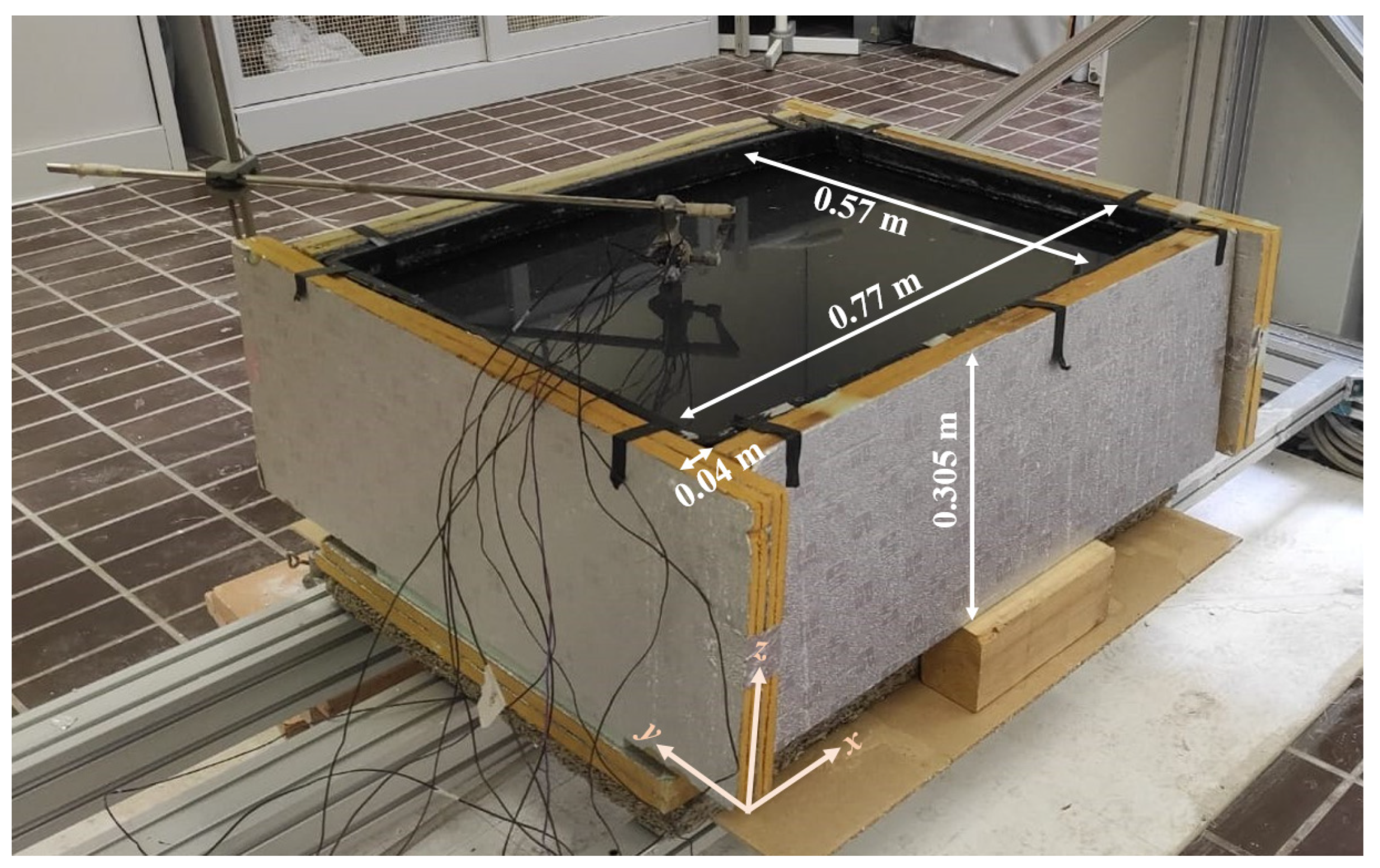
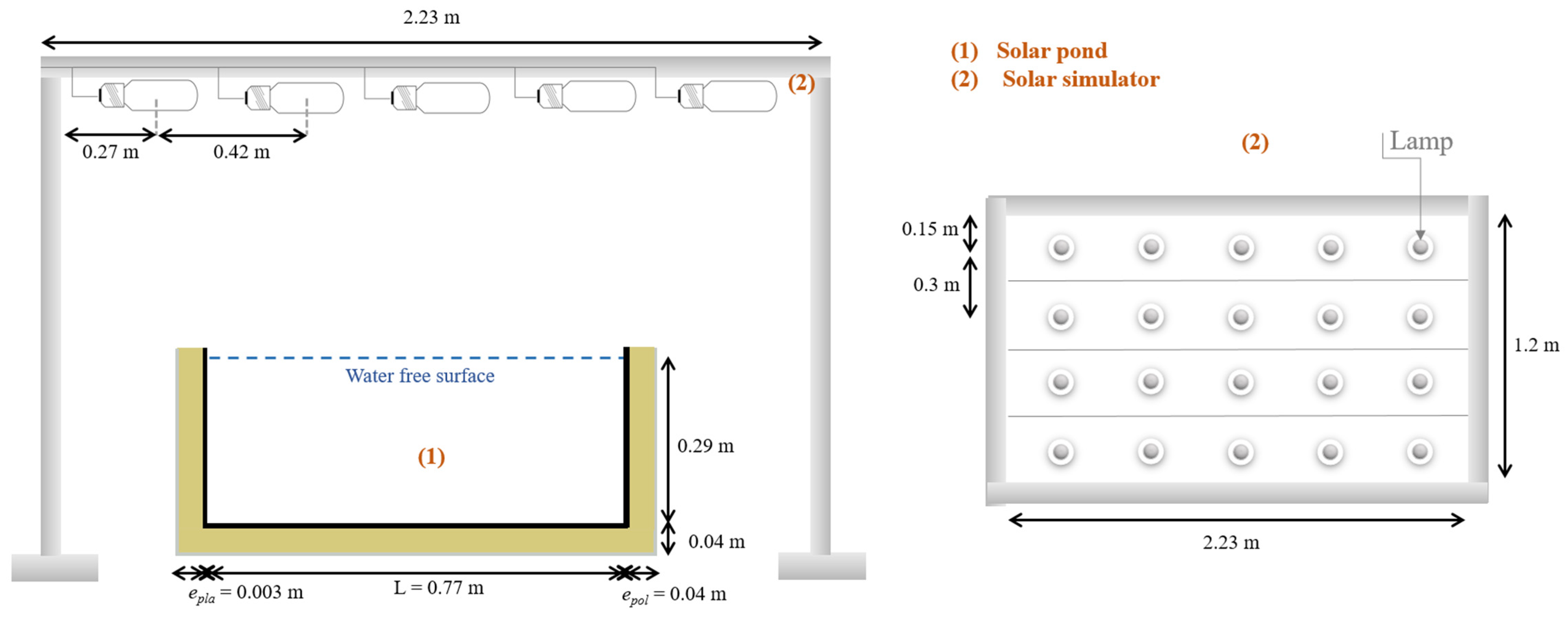
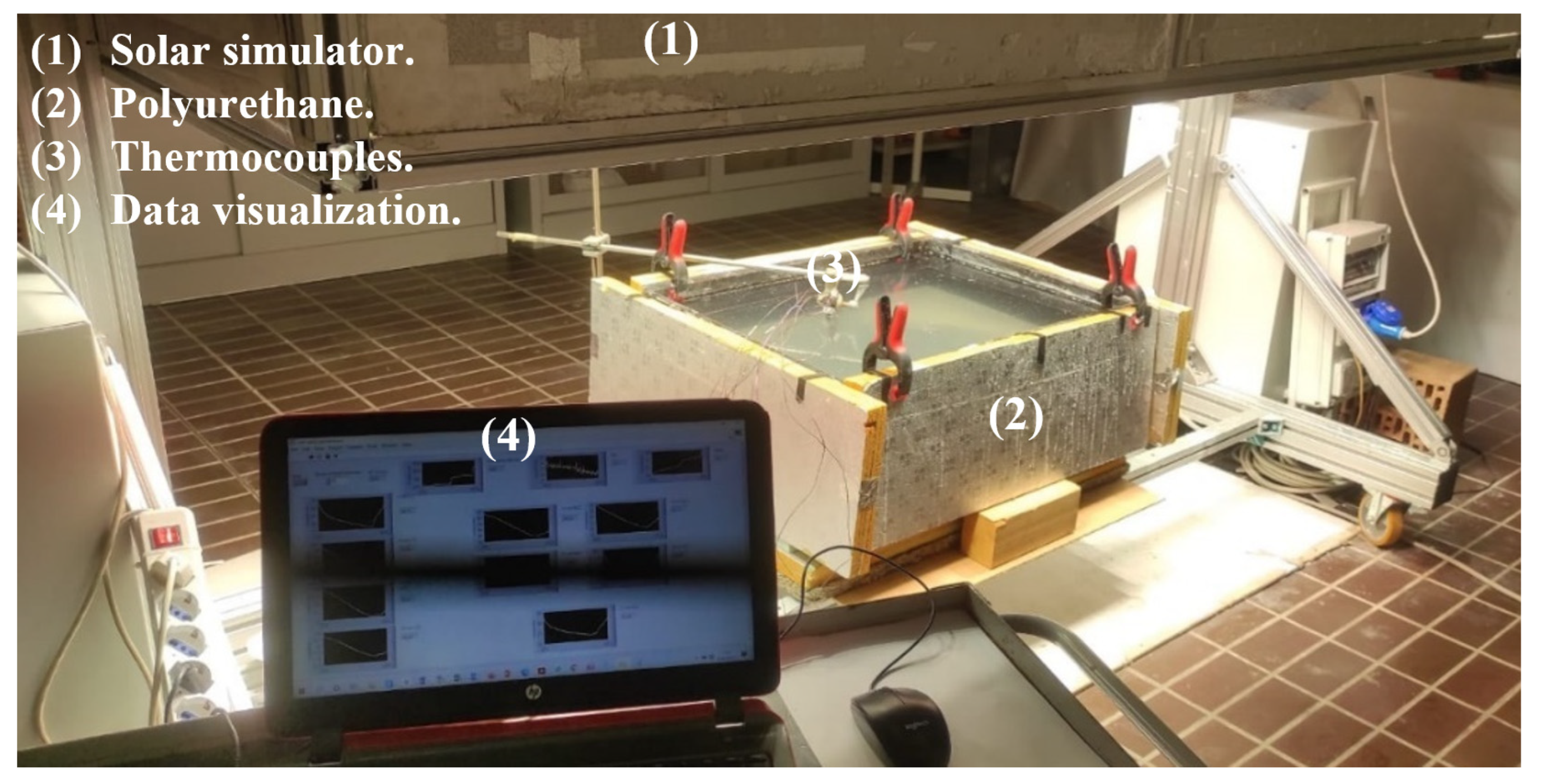

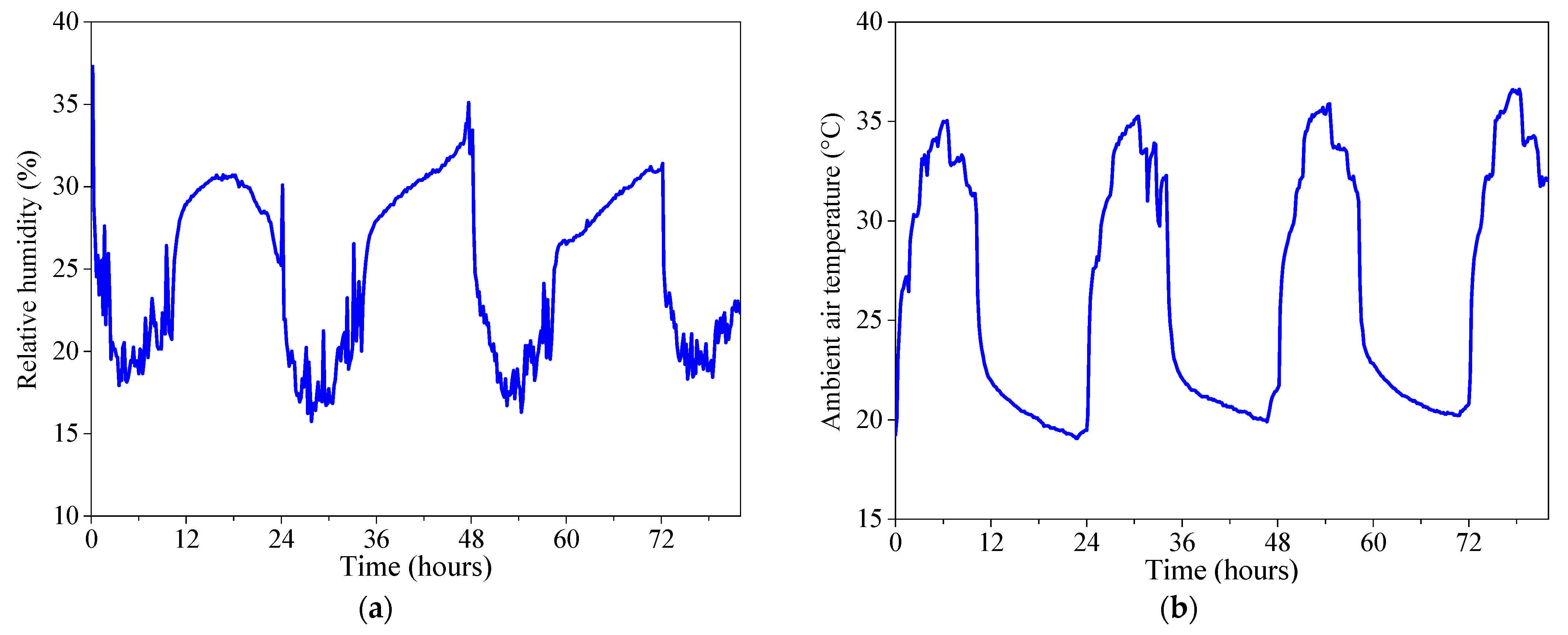
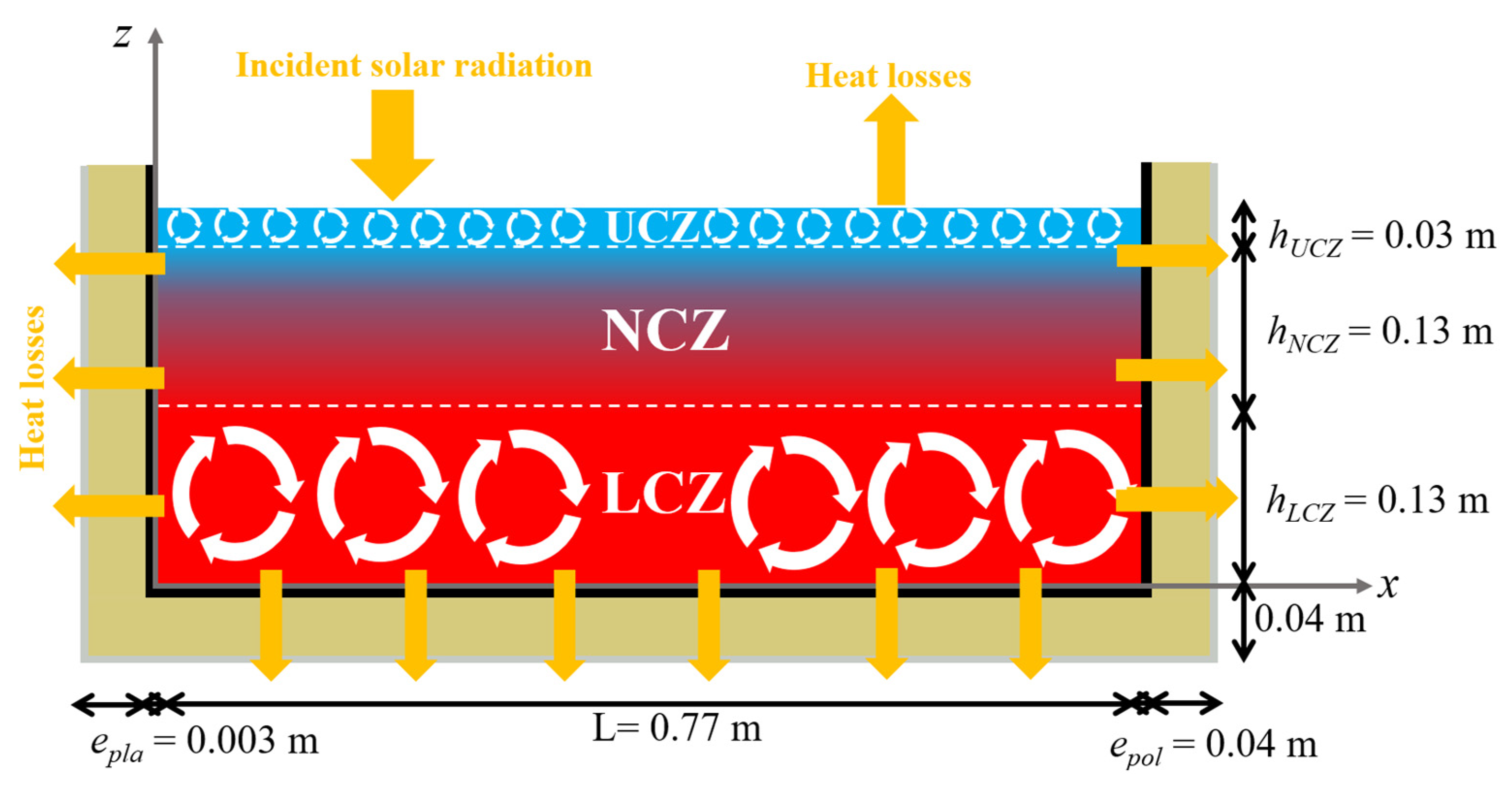
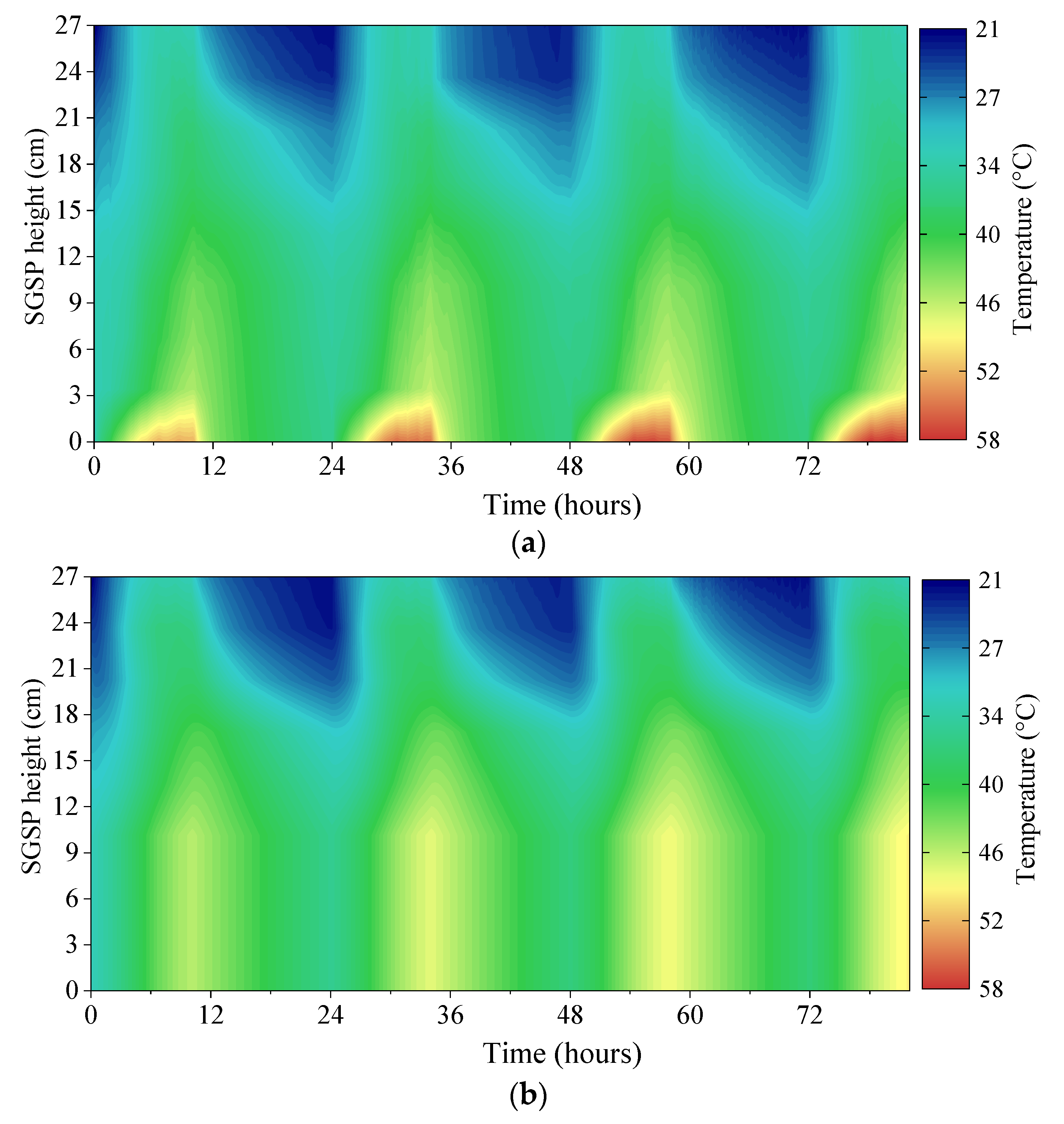

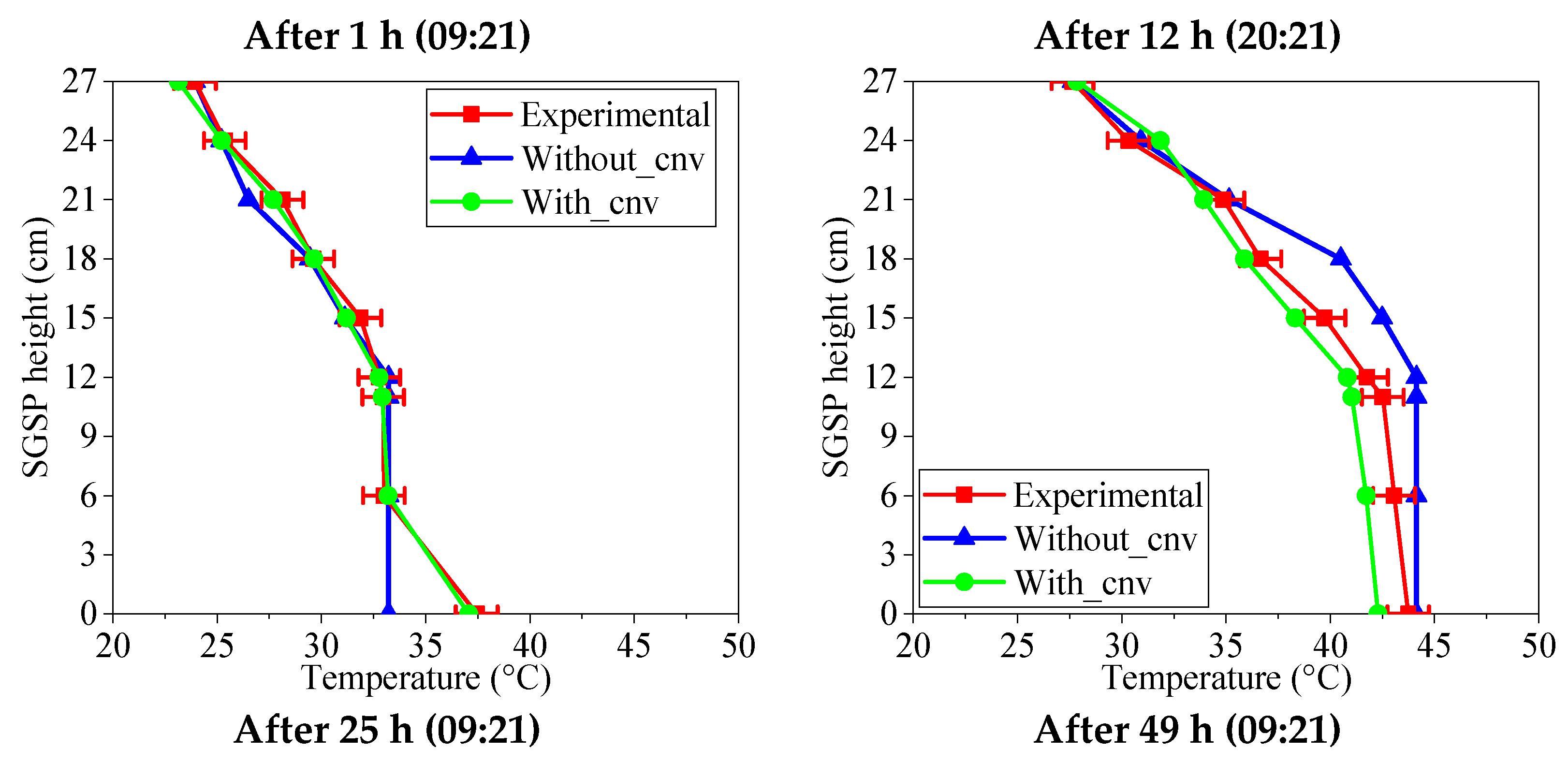

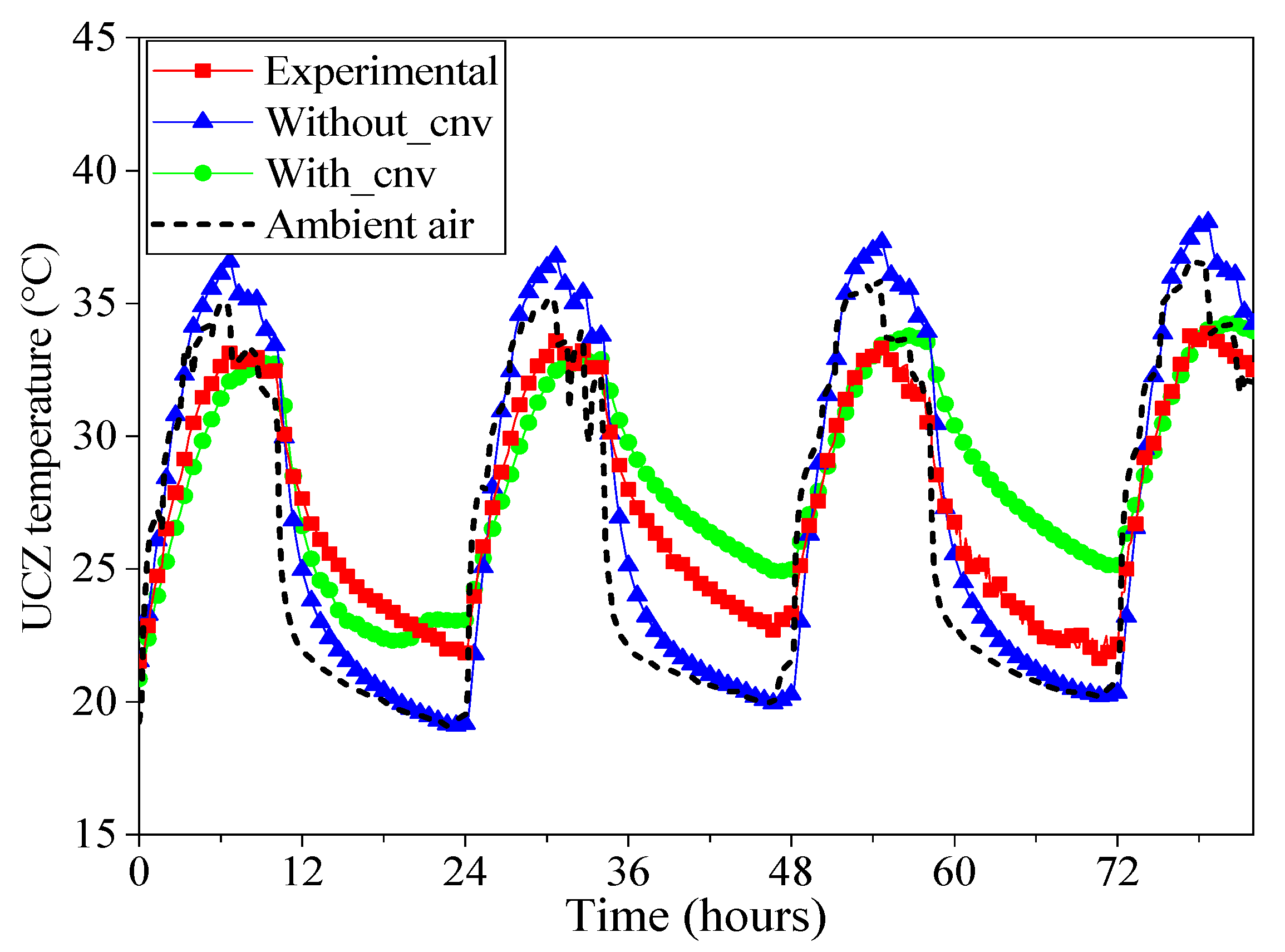
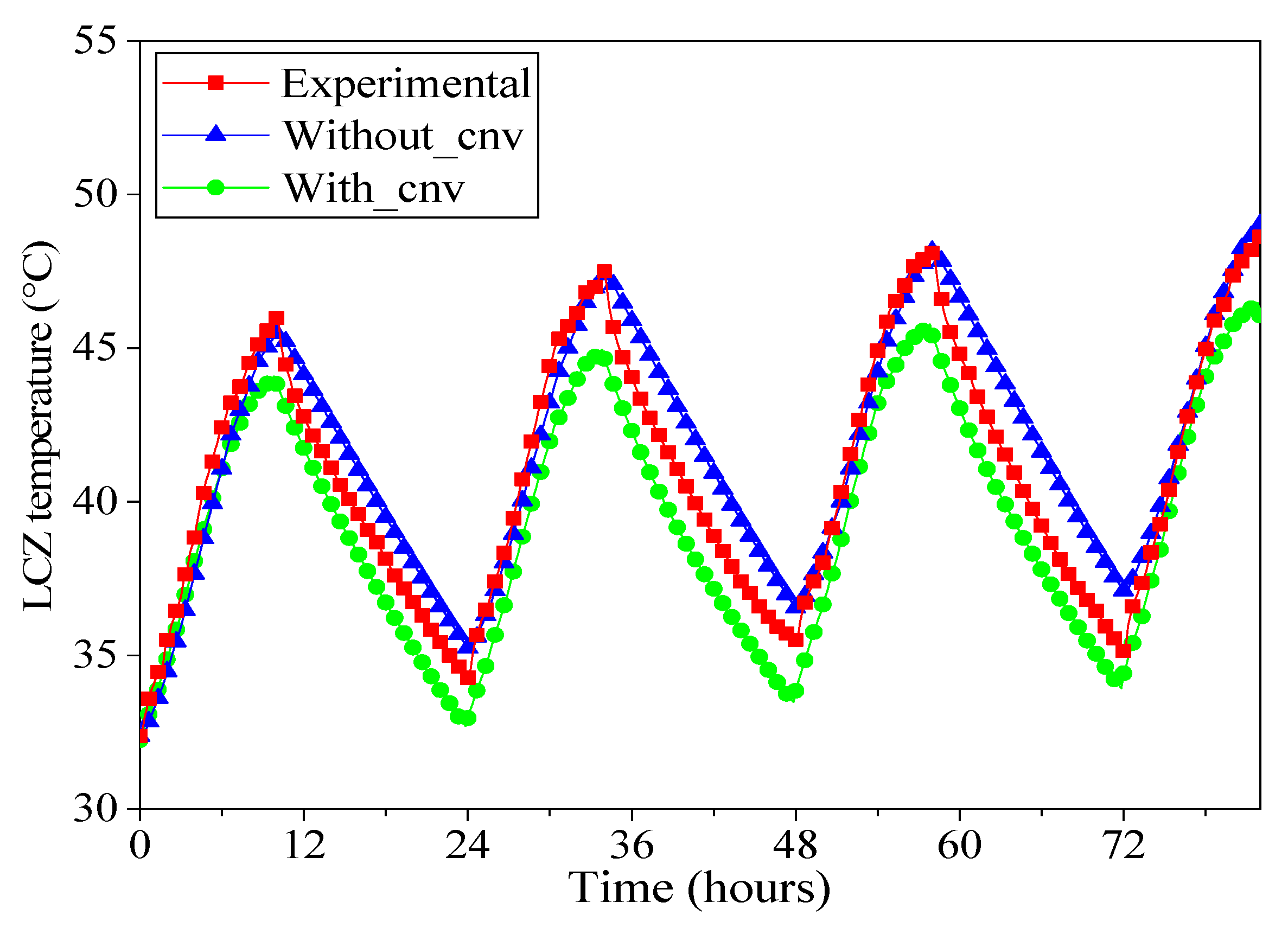
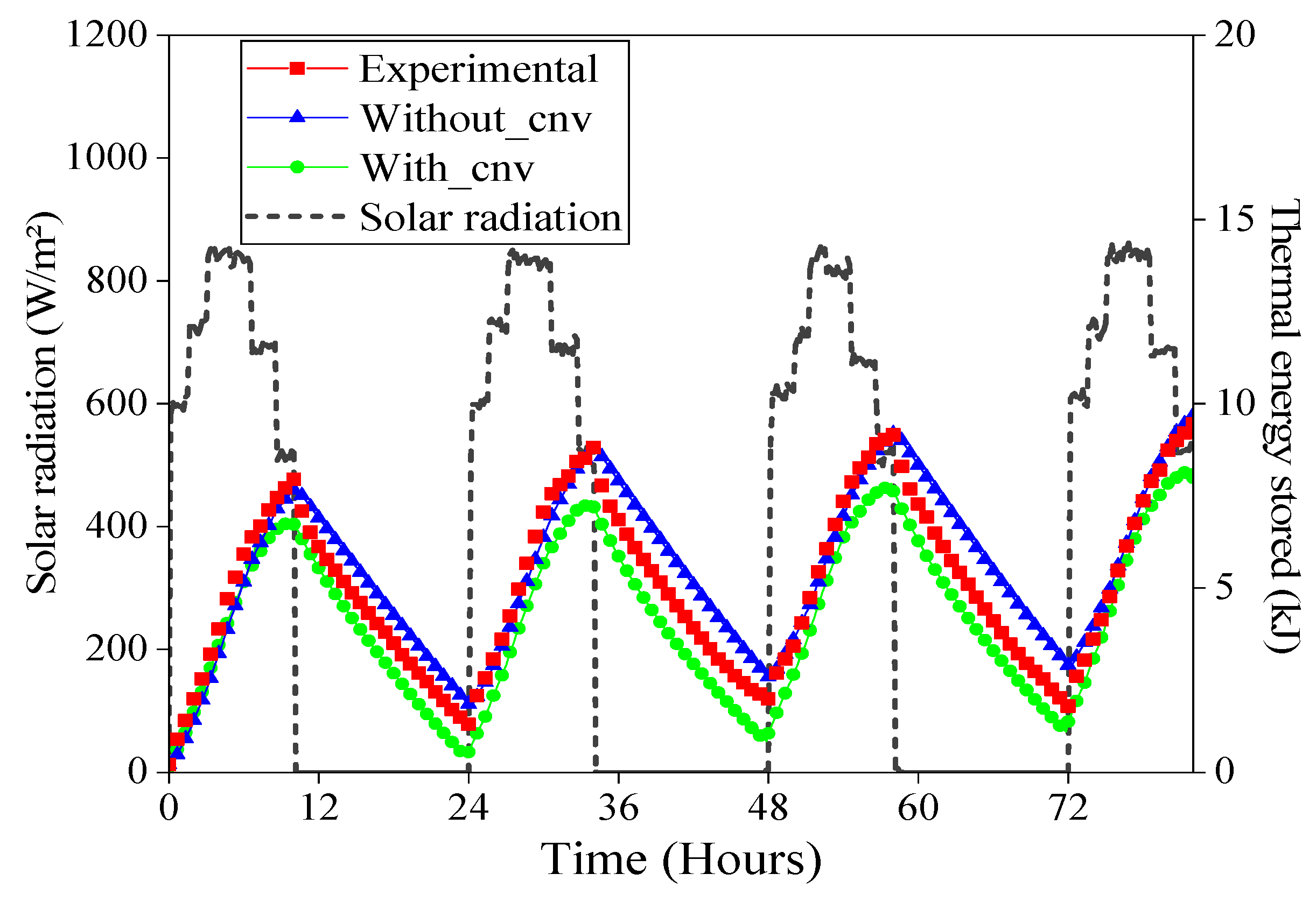
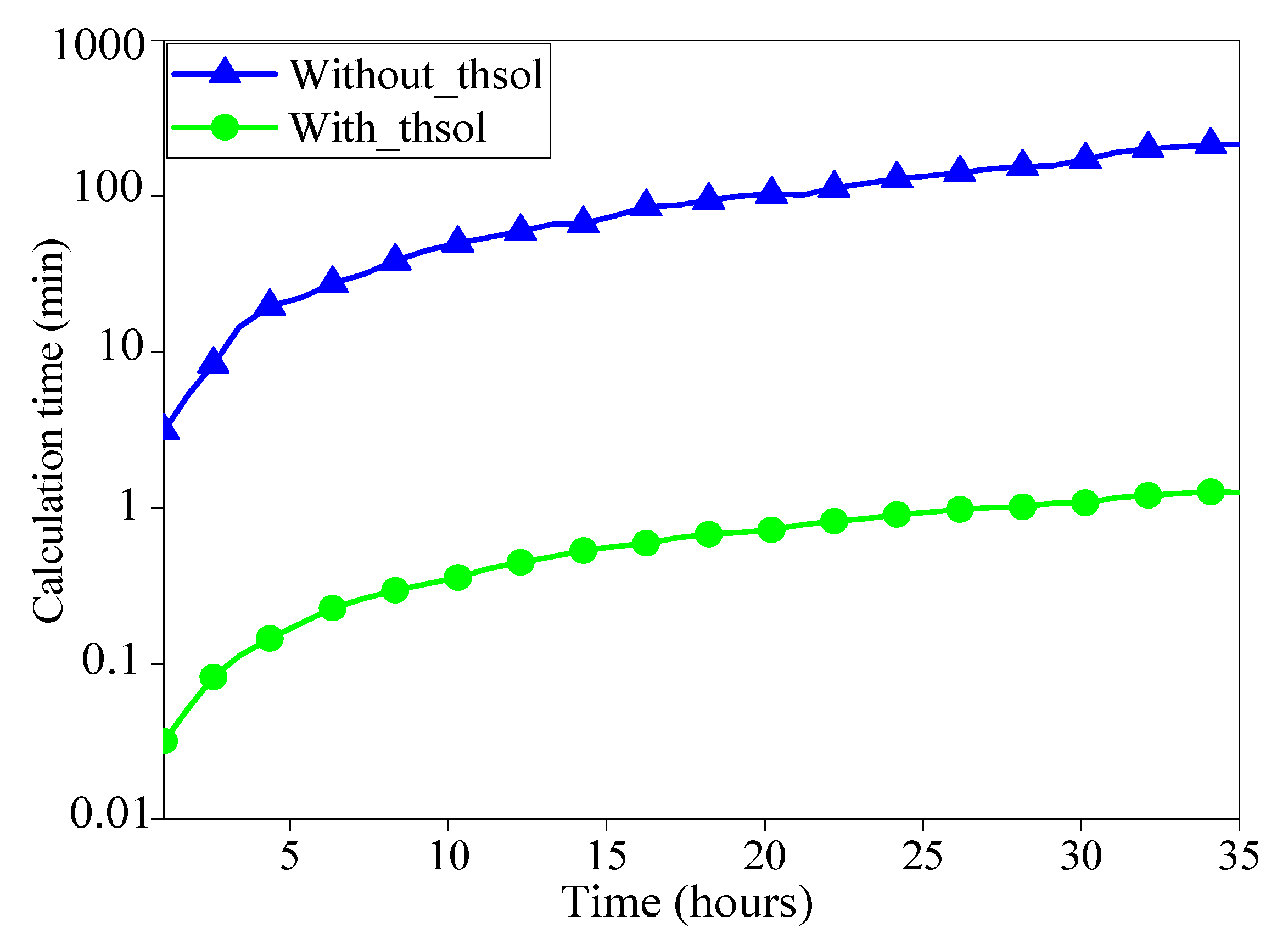
| Model Number | Property | Accuracy |
|---|---|---|
| T-type thermocouples | Temperature | ±1.0 °C |
| DPA/ESR 154 pyranometer | Solar radiation | <5% |
| Omega HX93BD | Temperature | ±0.6 °C |
| Omega HX93BD | Relative humidity | ±2.5% |
| Boundary Locations | Velocity | Temperature | Salt Concentration |
|---|---|---|---|
| 0 m/s | |||
| 0 m/s | |||
| 0 m/s | |||
| 0 m/s |
| LCZ Temperature | UCZ Temperature | |||||
|---|---|---|---|---|---|---|
| Maximum (°C) | Minimum (°C) | Average Relative Error (%) | Maximum (°C) | Minimum (°C) | Average Relative Error (%) | |
| Experimental | 48.62 | 32.36 | - | 34.01 | 21.24 | - |
| With_cnv | 46.47 | 32.24 | 3.74 | 34.29 | 20.85 | 5.98 |
| Without_cnv | 49.12 | 32.28 | 2.92 | 38.06 | 19.04 | 9.39 |
Disclaimer/Publisher’s Note: The statements, opinions and data contained in all publications are solely those of the individual author(s) and contributor(s) and not of MDPI and/or the editor(s). MDPI and/or the editor(s) disclaim responsibility for any injury to people or property resulting from any ideas, methods, instructions or products referred to in the content. |
© 2023 by the authors. Licensee MDPI, Basel, Switzerland. This article is an open access article distributed under the terms and conditions of the Creative Commons Attribution (CC BY) license (https://creativecommons.org/licenses/by/4.0/).
Share and Cite
Rghif, Y.; Colarossi, D.; Principi, P. Effects of Double-Diffusive Convection on Calculation Time and Accuracy Results of a Salt Gradient Solar Pond: Numerical Investigation and Experimental Validation. Sustainability 2023, 15, 1479. https://doi.org/10.3390/su15021479
Rghif Y, Colarossi D, Principi P. Effects of Double-Diffusive Convection on Calculation Time and Accuracy Results of a Salt Gradient Solar Pond: Numerical Investigation and Experimental Validation. Sustainability. 2023; 15(2):1479. https://doi.org/10.3390/su15021479
Chicago/Turabian StyleRghif, Yassmine, Daniele Colarossi, and Paolo Principi. 2023. "Effects of Double-Diffusive Convection on Calculation Time and Accuracy Results of a Salt Gradient Solar Pond: Numerical Investigation and Experimental Validation" Sustainability 15, no. 2: 1479. https://doi.org/10.3390/su15021479
APA StyleRghif, Y., Colarossi, D., & Principi, P. (2023). Effects of Double-Diffusive Convection on Calculation Time and Accuracy Results of a Salt Gradient Solar Pond: Numerical Investigation and Experimental Validation. Sustainability, 15(2), 1479. https://doi.org/10.3390/su15021479








